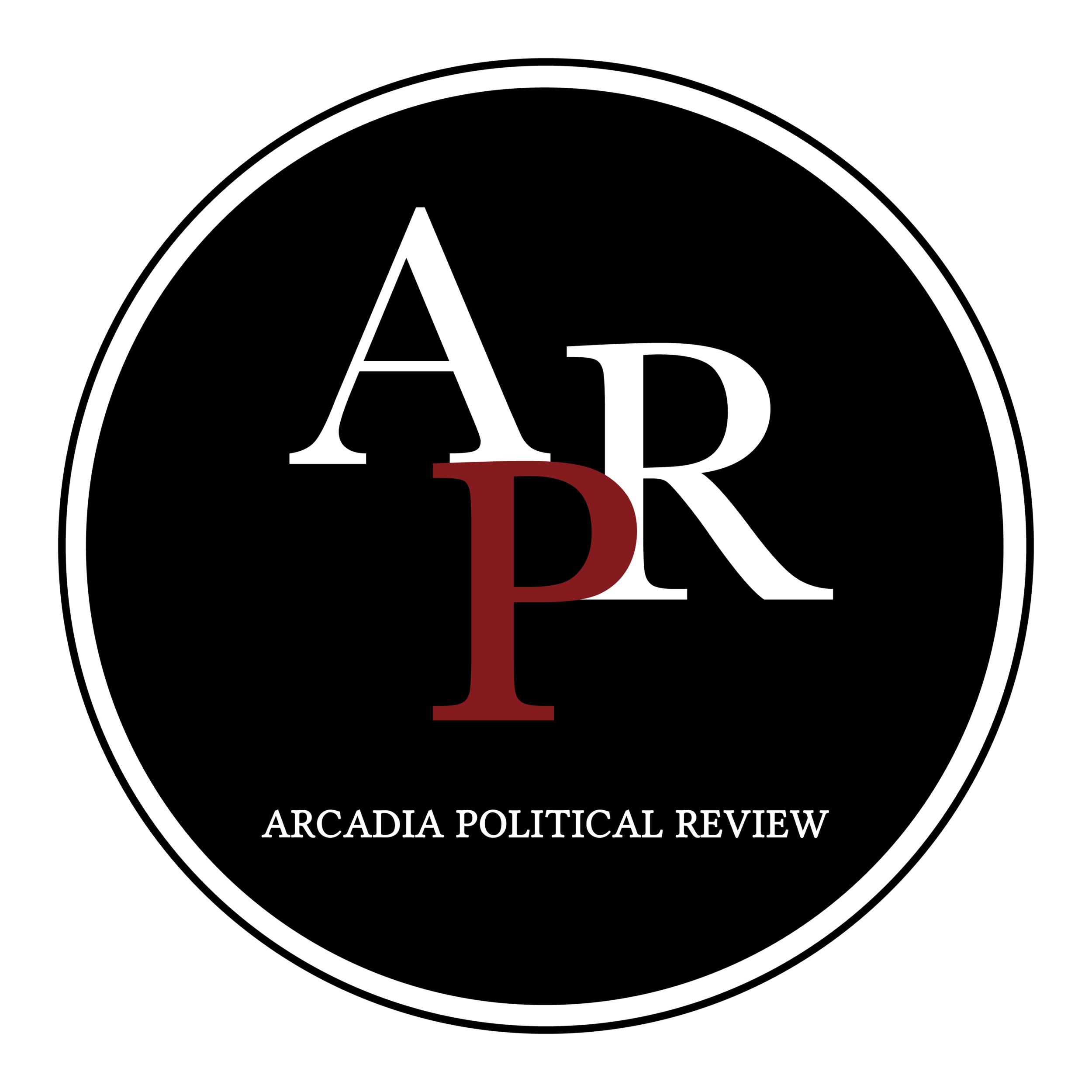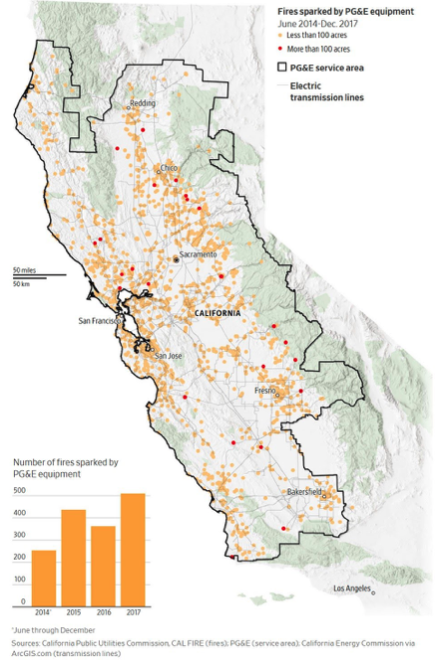Wildfires and The Utilities that Light Them
Of all the hot topics in the news today, nothing burns hotter than California’s wildfire crisis. America’s Tinderbox has been recording fire statistics since 1932 and the top ten biggest fires ever recorded in the state have all occurred after the year 2000 [1]. This trend towards bigger and more destructive fires is only expected to increase. Over a hundred years of fire suppression have turned the state’s forests into ready-made fire fuel, and climate change has turned the heat up every year, roasting an already dry region. Unfortunately for California, these are not quick fixes, although the Forest Service[2] and the State government[3] have both made inroads towards addressing the problems. However, if you recall from middle school science classes, fire requires another ingredient to ignite; all fires require a spark, or ignition source, to start. That source has a name in California, the most detested company in the state, Pacific Gas and Electric Company (PG&E).
According to The Wall Street Journal, PG&E supplies electrical power to the bulk of Northern California and has been connected to over 1,500 fires between June 2014 and December 2017. It was found at fault for the 2018 Camp Fire that engulfed the town of Paradise and killed 85 people, the state’s deadliest fire so far. The spark in that fire was particularly damning; a live power line broke off from a tower that had exceeded its expected structural lifespan by 25 years.[4] PG&E has a sordid history, including an investigation after a 2010 gas line explosion that killed 6 and a finding that from 2000-2010, gas and transmission revenues exceeded what it was authorized to collect by $224 million. Yet despite this revenue, spending fell $93 million short of its authorized budget between 1997 and 2000. PG&E also used millions of dollars less on operations and maintenance than it was supposed to.[5] To this day, they are still on probation from that investigation, but functionally nothing has changed. In 2017, regulators noted that PG&E lacked an overall safety strategy, was unclear in communicating about safety between management and workers in the field, and tended to take action only after a major disaster. Even politicians are disgusted with this investor-owned company’s focus on the bottom line and corner-cutting, as seen by Governor Gavin Newsom’s blast in a recent interview, when he said, “[PG&E] have simply been caught red-handed over and over again, lying, manipulating or misleading the public. They cannot be trusted.”[6]
Source: Wallstreet Journal
So if PG&E’s poor maintenance and safety practices are sparking wildfires, why is no one talking about it? Ultimately, it’s all about the money. While the company pled guilty to 84 counts of involuntary manslaughter in the case of the 2018 Camp Fire and agreed to pay the devastated Butte County $4 million in penalties, they were already in Chapter 11 bankruptcy at this point. Actually, PG&E owes over $30 billion in liabilities, three times what the company as a whole is worth.[7] There is simply no way to pay everyone. The State government had no choice; if it wanted to keep the lights on for its denizens, it had to secure the debt. In July 2019, CA Assembly Bill 1054 created a Wildfire Fund to the tune of $21 billion to be used specifically to pay for property damages caused by a utility-ignited wildfire.[8] This bailed out not just PG&E, but also the other CA utility companies, Southern California Edison and San Diego Gas and Electric. While the companies are required to cover half of the fund, the remaining portion is coming from a surcharge on all state residents’ energy bills. What a wonderful place to live, where homeowners have to bail out the cause of their houses' destruction.
How can this situation be turned around? San Diego’s utility company may have the answer. After being at fault for a devastating fire in 2007, SDGE spent $1.5 billion on upgrades to its infrastructure monitoring, adding cameras to every tower, transformer, and pole no matter how distant. It pushed regulators to allow safety measures above and beyond what was required, breaking its electrical grid into smaller segments for easier control and clearing trees away from its power lines. Since then, SDGE has been a national leader in safety and wildfire prevention, and it has paid off. While the world talks about record-breaking firestorms in Northern California, San Diego, California’s most fire-prone region, has NOT made the news with any flare-ups. This relative success puts California’s wildfire crisis in perspective, especially when PG&E’s response to potential fire conditions is to regularly shut down the grid in prescribed shutdown’s known as “rolling blackouts.” With the 2019 and 2020 fires still under investigation in the courts, it may be too early to point fingers at the utility companies just yet, but PG&E and Southern Edison’s recent policies of cutting power to potential hotspots is clearly not working. Rather than making a concentrated effort to update their power systems and clear dry trees away from lines, these two utilities are forcing millions of Californians to endure rolling blackouts for days at a time on the off chance it will prevent a wayward power line from finding its way into a dry tree. Suddenly, a much better use for that taxpayer-fed Wildfire Fund presents itself. If it takes billions of dollars to update and upgrade the electrical grid, why aren’t we using that fund to fix the system instead of paying for the utility companies’ failures? Why must we choose between wildfires or blackouts? And above all, why are we still letting a criminally-negligent company like Pacific Gas and Electric still exist, knowing it will cause more harm?
Sources:
Rosenberg, Lizzy. “Here's Why California Seems to Be the Victim of So Many Devastating Wildfires.” Green Matters. Green Matters, September 30, 2020. https://www.greenmatters.com/p/why-does-california-have-so-many-wildfires.
Leman, Jennifer. “Over 30 Wildfires Are Burning in California Right Now.” Popular Mechanics. Popular Mechanics, August 24, 2020. https://www.popularmechanics.com/science/environment/a29623250/california-fires/.
Woolfolk, John. “Who's to Blame for California's Planned Power Outages? Some Say PG&E, Others Say Politicians.” The Mercury News. The Mercury News, October 31, 2019. https://www.mercurynews.com/2019/10/30/whos-to-blame-for-power-outages-and-wildfires/.
Penn, Ivan, Peter Eavis, and James Glanz. “California Wildfires: How PG&E Ignored Risks in Favor of Profits.” The New York Times. The New York Times, March 19, 2019. https://www.nytimes.com/interactive/2019/03/18/business/pge-california-wildfires.html.
McFall-Johnsen, Morgan. “Over 1,500 California Fires in the Past 6 Years - Including the Deadliest Ever - Were Caused by One Company: PG&E. Here's What It Could Have Done but Didn't.” Business Insider. Business Insider, November 3, 2019. https://www.businessinsider.com/pge-caused-california-wildfires-safety-measures-2019-10.
Penn, Ivan, and Peter Eavis. “PG&E's Plan to Resolve Bankruptcy Wins Court Approval.” The New York Times. The New York Times, June 19, 2020. https://www.nytimes.com/2020/06/19/business/energy-environment/pge-bankruptcy-court-approval.html.
Gold, Russell, Katherine Blunt, and Rebecca Smith. “PG&E Sparked at Least 1,500 California Fires. Now the Utility Faces Collapse.” The Wall Street Journal. Dow Jones & Company, January 13, 2019. https://www.wsj.com/articles/pg-e-sparked-at-least-1-500-california-fires-now-the-utility-faces-collapse-11547410768.
Nikolewski, Rob. “California Regulators Approve Funding for Controversial Wildfire Law.”Tribune. San Diego Union-Tribune, October 25, 2019. https://www.sandiegouniontribune.com/business/energy-green/story/2019-10-24/california-regulators-approve-funding-for-controversial-wildfire-law.

